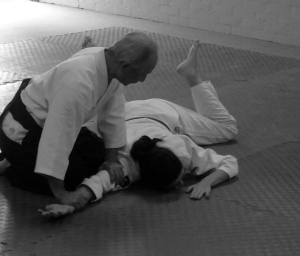 Suwari waza (sometimes referred to as Zagi waza) is a form of Aikido practice performed from the initial position of nage and uke sitting opposite and facing each other while kneeling (seiza).
Suwari waza (sometimes referred to as Zagi waza) is a form of Aikido practice performed from the initial position of nage and uke sitting opposite and facing each other while kneeling (seiza).
In the below video Takeda Satoshi Sensei (7th Dan AKI Aikikai) demonstrates the application of Aiki principles for Suwari waza where the uke strikes the temple of the nage. This form of traditional attack is referred to as shomenuchi.
As Sensei is exploring responses from Suwari waza shomenuchi from a purely Aiki perspective, there is no predetermined outcome or pin as occurs when practising purely syllabus based Aikido. The focus is on principle, with particular emphasis on not meeting an attack with physical resistance.
The above video was recorded at our dojo on 25 November 2017 as part of a special class by Takeda Satoshi Sensei during his 2017 visit to Australia.
Have a great weekend
Ian Grant
Dojo Cho
Fudoshin Warrior Dojo
Aikido Kenkyukai, Brisbane





You must be logged in to post a comment.